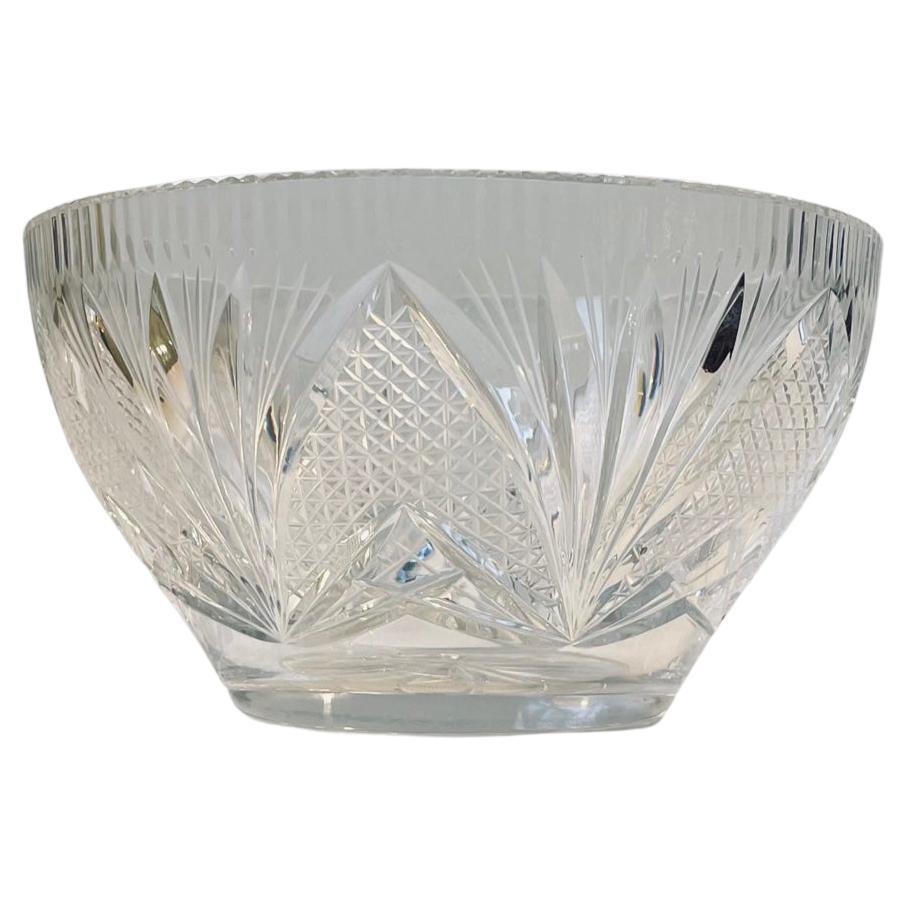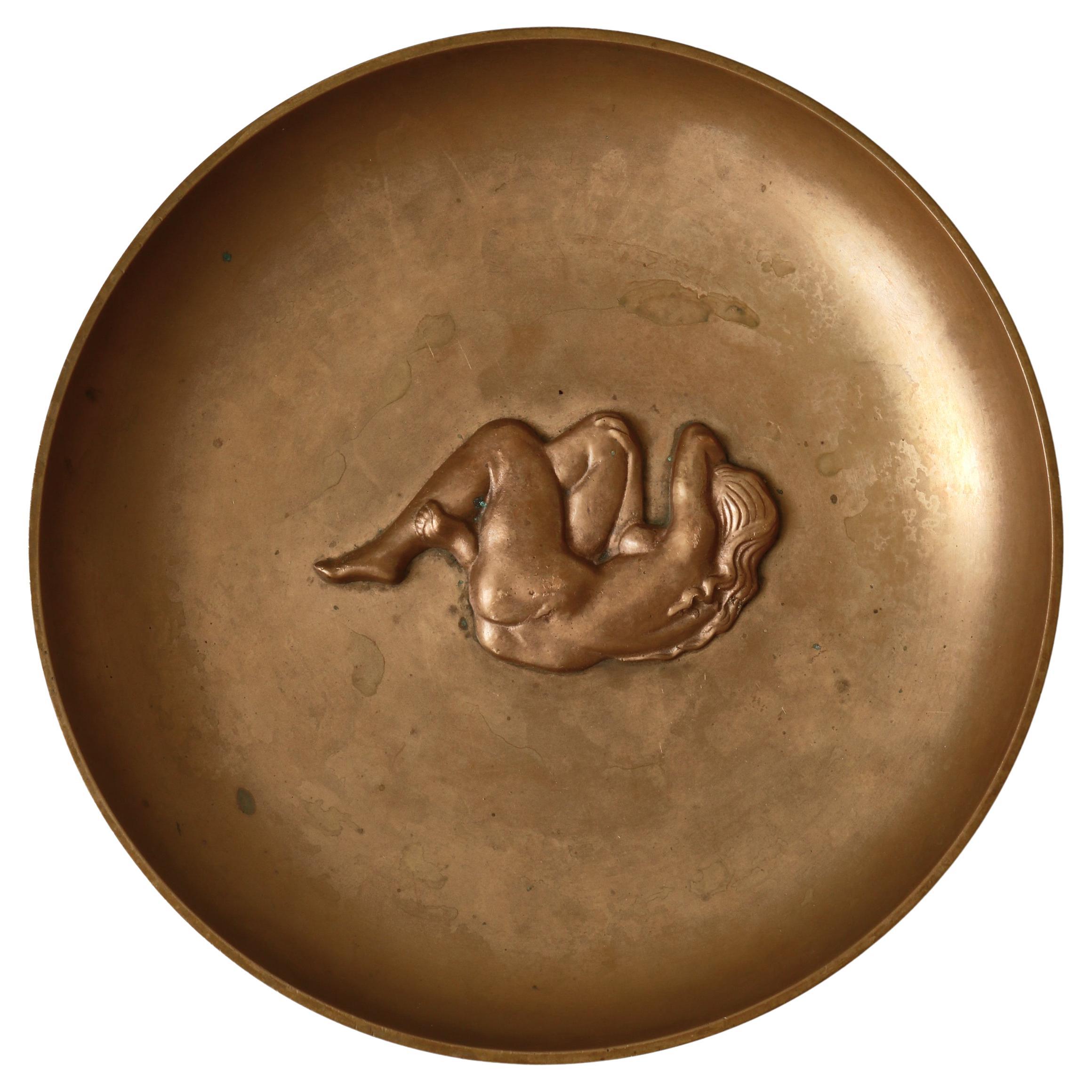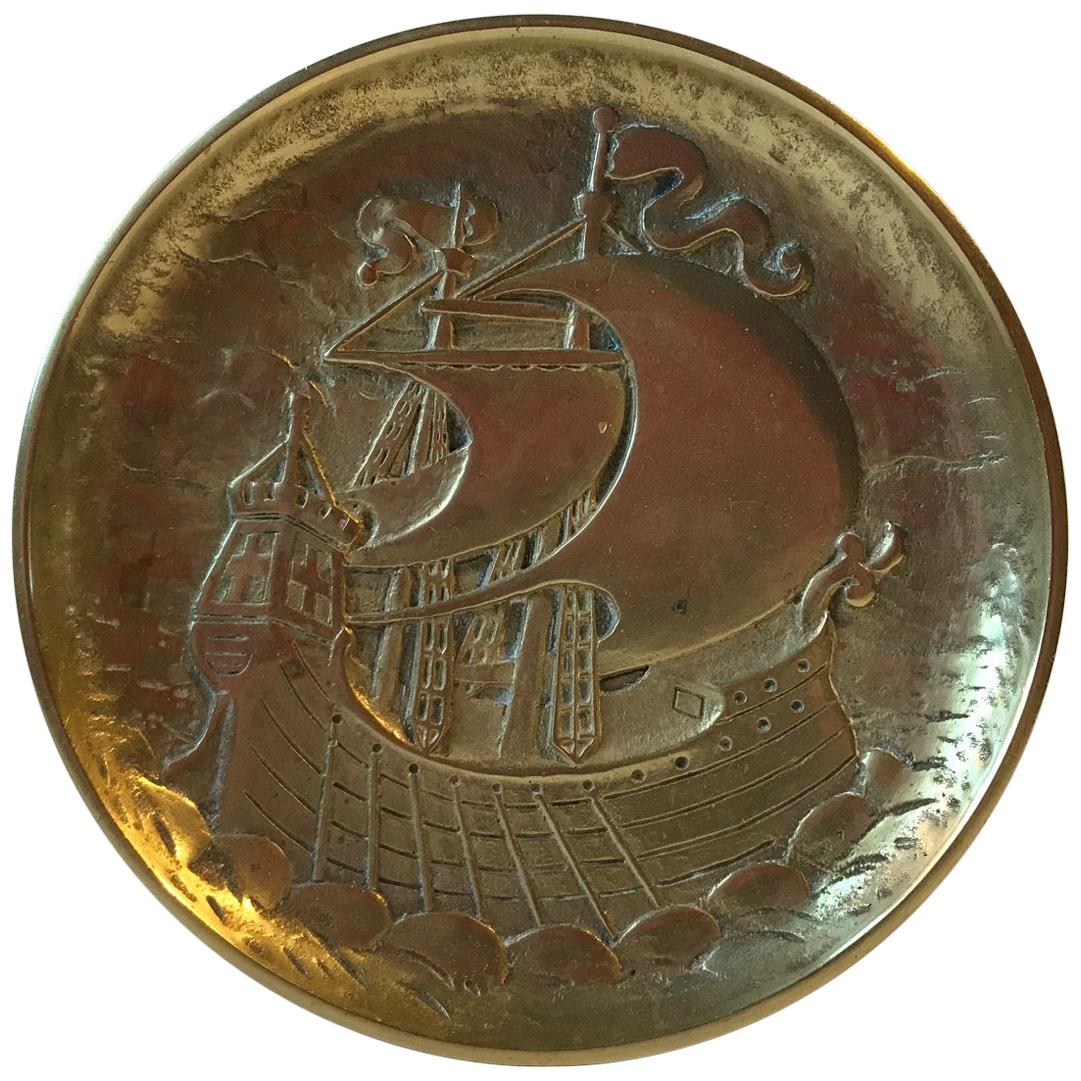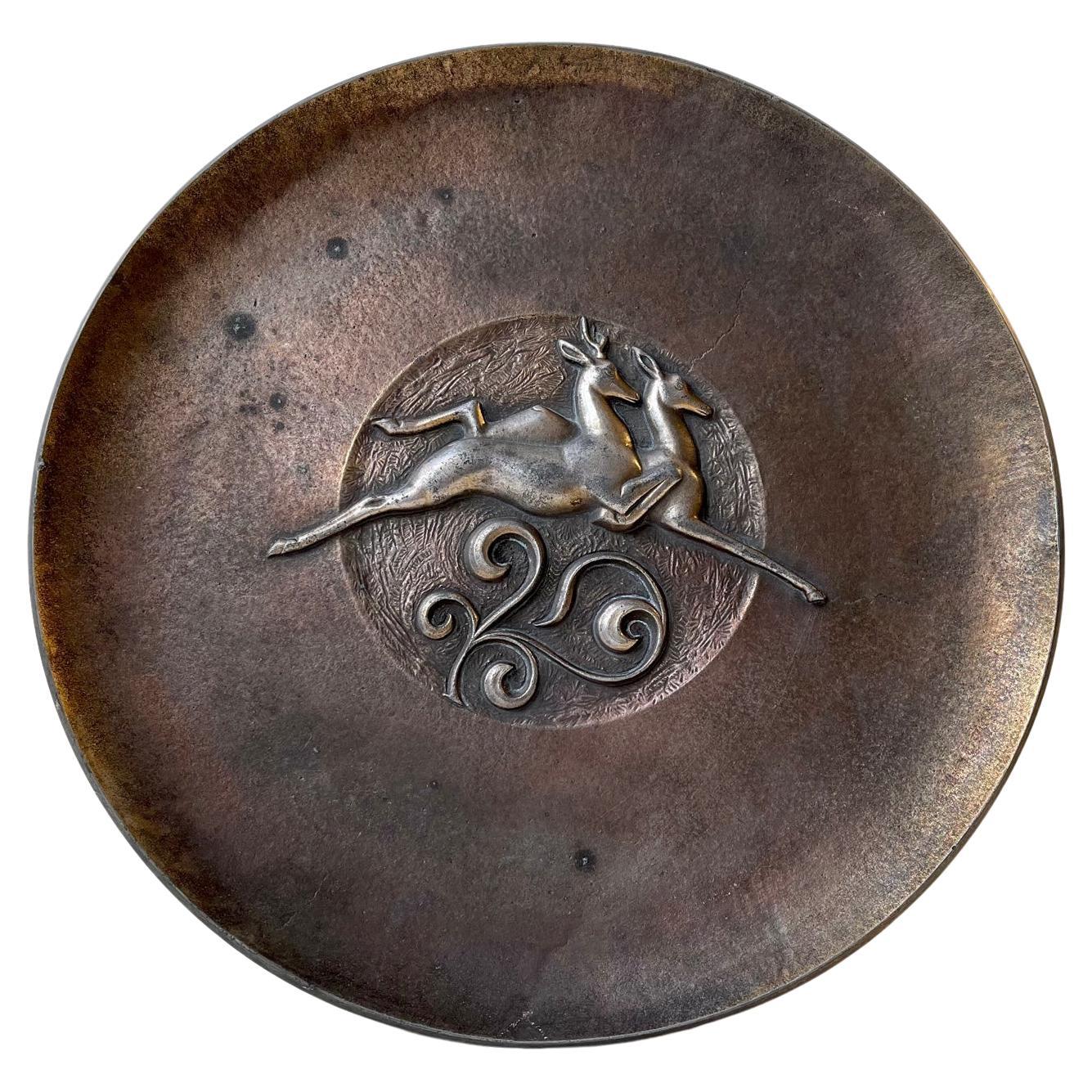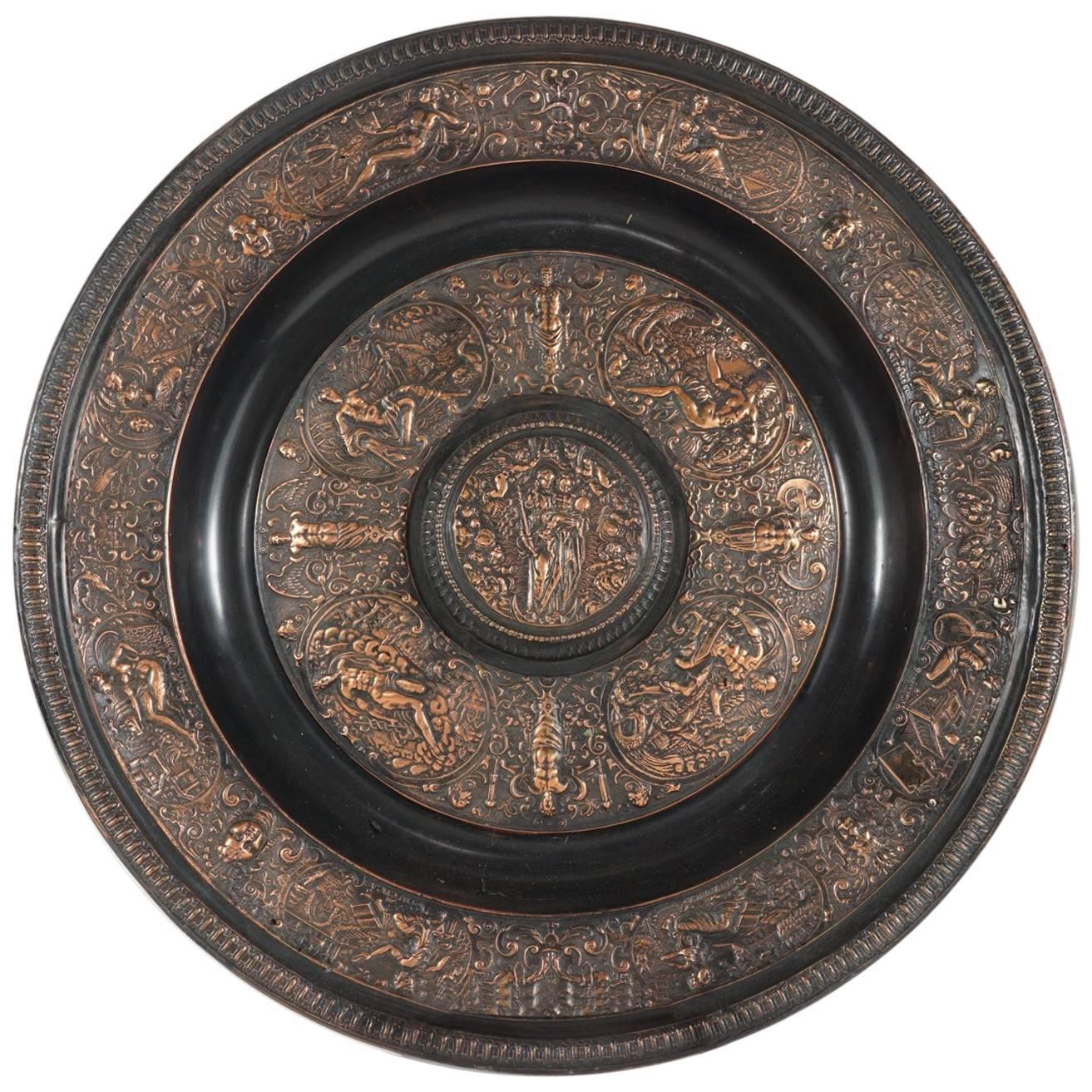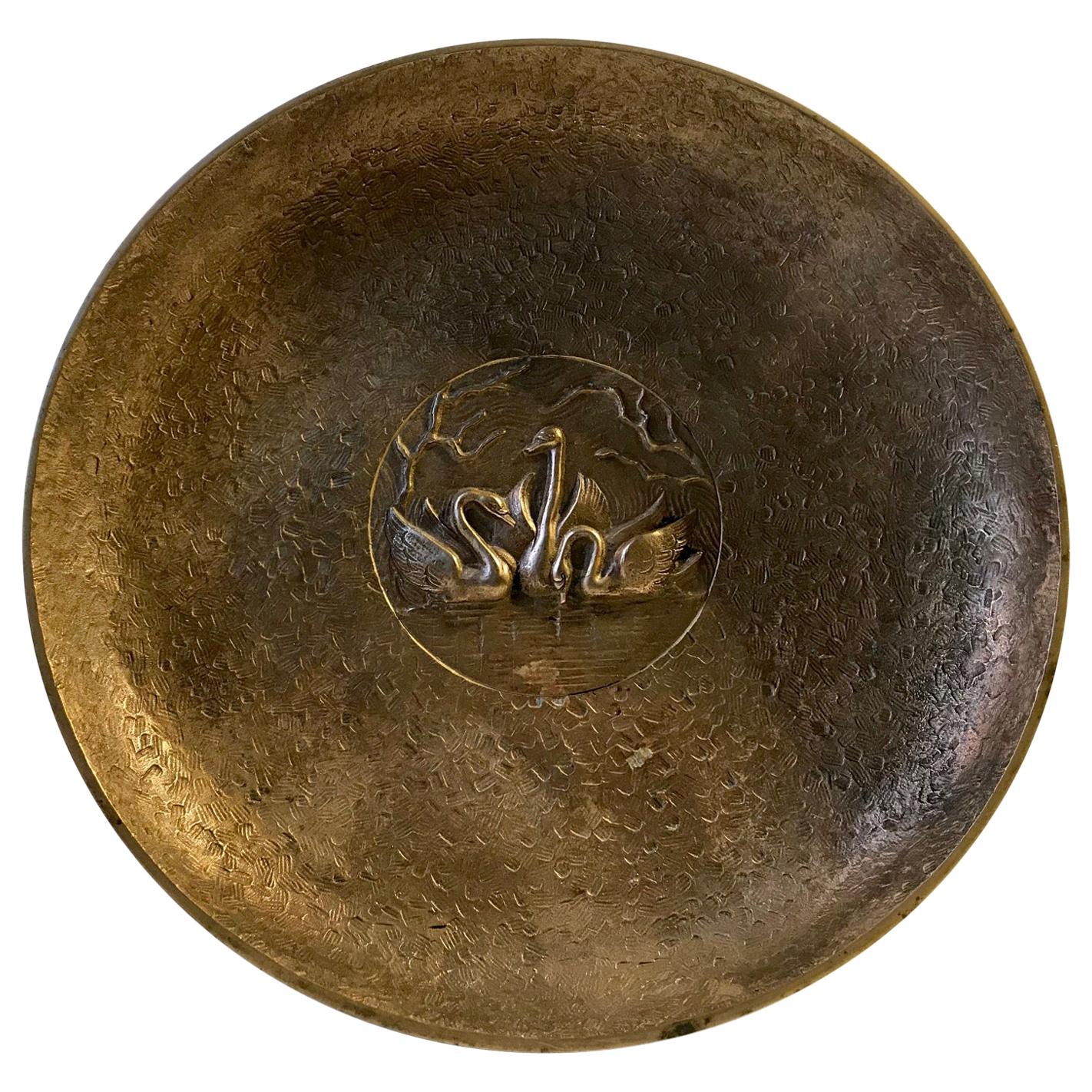Items Similar to Scandinavian Patinated Bronze Charger with Lucifer, Satan, 1930s
Want more images or videos?
Request additional images or videos from the seller
1 of 7
Scandinavian Patinated Bronze Charger with Lucifer, Satan, 1930s
About the Item
Unusual Cast bronze dish with green verdigris patina. It features scenes from the old testement with depictions of Lucifer - Satan cast in relief around its perimeter. Signed to its back: Memories from Sepstrup in Danish. Sepstrup is a small town in Jutland Denmark. Thats all we know. Measurements: D: 29.5 cm, H: 3.5 cm.
- Dimensions:Height: 1.38 in (3.5 cm)Diameter: 11.62 in (29.5 cm)
- Style:Art Deco (Of the Period)
- Materials and Techniques:Bronze,Patinated
- Place of Origin:
- Period:
- Date of Manufacture:1930s
- Condition:Wear consistent with age and use. Original condition with superficial ware and patina consistent with its age. The edge is slightly uneven.
- Seller Location:Esbjerg, DK
- Reference Number:1stDibs: LU1782227940672
About the Seller
4.9
Platinum Seller
These expertly vetted sellers are 1stDibs' most experienced sellers and are rated highest by our customers.
Established in 2010
1stDibs seller since 2016
1,092 sales on 1stDibs
Typical response time: 1 hour
- ShippingRetrieving quote...Ships From: Esbjerg, Denmark
- Return PolicyA return for this item may be initiated within 14 days of delivery.
More From This SellerView All
- Scandinavian Cut Crystal Bowl, 1930sLocated in Esbjerg, DKAn intricately cut and engraved lead crystal bowl. Decorated with floral impressions. Made in Scandinavia probably by Orrefors circa 1930-40. Measu...Category
Vintage 1930s Scandinavian Art Deco Decorative Bowls
MaterialsCrystal
- Art Deco Bronze Dish with Frigate, 1930sLocated in Esbjerg, DKA nautical themed heavy bronze dish or ashtray depicting a 17th century Frigate (Fregat) battleship. It was made in Denmark during the 1930s. Distinct Art Deco styling to the slightl...Category
Vintage 1930s Danish Art Deco Decorative Dishes and Vide-Poche
MaterialsBronze
- Art Deco Bronze Dish with Antelopes, 1930sLocated in Esbjerg, DKA stylish bronze dish, plate or flat centerpiece bowl. Beautiful natural silvery-copper patina. Its has a center motif of antelopes in relief. Its European made probably Scandinavia,...Category
Vintage 1930s European Art Deco Decorative Dishes and Vide-Poche
MaterialsBronze
- Tinos Art Deco Bronze Dish with Swans, 1930sBy TinosLocated in Esbjerg, DKHand-decorated, textured and heavy Art Deco bronze bowl or dish with a center-motif of swans in relief. Designed and manufactured by Tinos in Copenhagen Denmark during the 1930s. The...Category
Vintage 1930s Danish Art Deco Decorative Dishes and Vide-Poche
MaterialsBronze
- Art Deco Bronze Dish With Grapes by Ægte Ildfast, 1930sBy IldfastLocated in Esbjerg, DKA polished Bronze dish or bowl decorated with relief motif of grapes. Designed and manufactured by Ægte Ildfast Bronce in Denmark during the 1930s in a s...Category
Vintage 1930s European Art Deco Decorative Dishes and Vide-Poche
MaterialsBronze
- Art Deco Bronze Dish with Stag by Crown Copenhagen, 1930sLocated in Esbjerg, DKHeavy solid bronze bowl/dish with elephant skin texture and a center-motif of a stylized stag in relief. It was designed and manufactured by Crown in Copenhagen Denmark during the 19...Category
Vintage 1930s Danish Art Deco Decorative Bowls
MaterialsBronze
You May Also Like
- Large Danish Modern "Tinos" Tray in Patinated Bronze, 1930s Art DecoBy TinosLocated in Odense, DKBeautifully patinated art deco "Tinos" dish or tray made in Denmark in the 1930s. Signed on back.Category
Vintage 1930s Danish Art Deco Decorative Dishes and Vide-Poche
MaterialsBronze
- Cast Bronze Copper Flashed Patinated Renaissance Style ChargerLocated in Hudson, NYThis charger made as an intentional remake of a famous object is fully embossed on the back as such and contains the maker's name. The charger contains many different scenes from ant...Category
Early 20th Century European Renaissance Decorative Bowls
MaterialsCopper, Bronze
- Art Deco French Marble Bowl with Curious Bronze Foxes, 1930sLocated in BAAMBRUGGE, NLA charming and funny bowl made of marble. With three bronze foxes looking curiously over the edge of the bowl. Made in France in the 1930s.Category
Vintage 1930s French Art Deco Decorative Bowls
MaterialsMarble, Bronze
- Evan Jensen Bronze Dish, Denmark, 1930sBy Evan JensenLocated in Valby, 84Bronze Art deco dish/charger by Danish artist Evan Jensen from the 1930's in a beautiful original condition, the dish is signed Evan Jensen Copenhagen Bronze and has model number 320. The dish has a very decorative image of a deer on the front. The dish is the perfect dish to have standing as a piece of art but can also be used as a bowl to store stuff like fruit or nuts or whatever else you could think of. Art Deco, short for the French Arts Décoratifs, and sometimes just called Deco, is a style of visual arts, architecture, and product design, that first appeared in France in the 1910s (just before World War I), and flourished in the United States and Europe during the 1920s and 1930s. Through styling and design of the exterior and interior of anything from large structures to small objects, including how people look (clothing, fashion and jewelry), Art Deco has influenced bridges, buildings (from skyscrapers to cinemas), ships, ocean liners, trains, cars, trucks, buses, furniture, and everyday objects like radios and vacuum cleaners. It got its name after the 1925 Exposition internationale des arts décoratifs et industriels modernes (International Exhibition of Modern Decorative and Industrial Arts) held in Paris. Art Deco combined modern styles with fine craftsmanship and rich materials. During its heyday, it represented luxury, glamour, exuberance, and faith in social and technological progress. From its outset, Art Deco was influenced by the bold geometric forms of Cubism and the Vienna Secession; the bright colours of Fauvism and of the Ballets Russes; the updated craftsmanship of the furniture of the eras of Louis XVI and Louis Philippe I; and the exoticized styles of China, Japan, India, Persia, ancient Egypt and Maya art. It featured rare and expensive materials, such as ebony and ivory, and exquisite craftsmanship. The Empire State Building, Chrysler Building, and other skyscrapers of New York City built during the 1920s and 1930s are monuments to the style. In the 1930s, during the Great Depression, Art Deco became more subdued. New materials arrived, including chrome plating, stainless steel and plastic. A sleeker form of the style, called Streamline Moderne, appeared in the 1930s, featuring curving forms and smooth, polished surfaces. Art Deco is one of the first truly international styles, but its dominance ended with the beginning of World War II and the rise of the strictly functional and unadorned styles of modern architecture and the International Style of architecture that followed. This dish is the perfect detail for any interior from the modern Wabi Sabi style...Category
Vintage 1930s Danish Scandinavian Modern Decorative Dishes and Vide-Poche
MaterialsBronze
- Agentor Art Deco Bronze tray Denmark 1930sLocated in Valby, 84Beautiful patinaed Art Deco Bronze dish by danish manufacture Agentor from the 1930's. The Dish has the motive of a woman running with her hunting dog next to her. This dish is the perfect piece as a decorative element but can also be used as a fruit or nut bowl or whatever else you could think of. The dish is signed Agentor Bronce number 47. Art Deco, short for the French Arts Décoratifs, and sometimes just called Deco, is a style of visual arts, architecture, and product design, that first appeared in France in the 1910s (just before World War I), and flourished in the United States and Europe during the 1920s and 1930s. Through styling and design of the exterior and interior of anything from large structures to small objects, including how people look (clothing, fashion and jewelry), Art Deco has influenced bridges, buildings (from skyscrapers to cinemas), ships, ocean liners, trains, cars, trucks, buses, furniture, and everyday objects like radios and vacuum cleaners. It got its name after the 1925 Exposition internationale des arts décoratifs et industriels modernes (International Exhibition of Modern Decorative and Industrial Arts) held in Paris. Art Deco combined modern styles with fine craftsmanship and rich materials. During its heyday, it represented luxury, glamour, exuberance, and faith in social and technological progress. From its outset, Art Deco was influenced by the bold geometric forms of Cubism and the Vienna Secession; the bright colours of Fauvism and of the Ballets Russes; the updated craftsmanship of the furniture of the eras of Louis XVI and Louis Philippe I; and the exoticized styles of China, Japan, India, Persia, ancient Egypt and Maya art. It featured rare and expensive materials, such as ebony and ivory, and exquisite craftsmanship. The Empire State Building, Chrysler Building, and other skyscrapers of New York City built during the 1920s and 1930s are monuments to the style. In the 1930s, during the Great Depression, Art Deco became more subdued. New materials arrived, including chrome plating, stainless steel and plastic. A sleeker form of the style, called Streamline Moderne, appeared in the 1930s, featuring curving forms and smooth, polished surfaces. Art Deco is one of the first truly international styles, but its dominance ended with the beginning of World War II and the rise of the strictly functional and unadorned styles of modern architecture and the International Style of architecture that followed. This dish are the perfect detail for any interior from the modern Wabi Sabi style...Category
Vintage 1930s Danish Art Deco Decorative Dishes and Vide-Poche
MaterialsBronze
- Tinos, Small Bowl, Bronze, Denmark, 1930sBy TinosLocated in High Point, NCA bronze vase designed and produced by Tinos, Denmark, 1930s.Category
Vintage 1930s Danish Mid-Century Modern Decorative Bowls
MaterialsBronze
Recently Viewed
View AllMore Ways To Browse
Vintage 1930s Kitchen
Danish Patinated
Vintage Kitchens Of The 1930s
Bronze Scandinavian
Scandinavian Bronze
Green Verdigris
Bronze Reliefs Art Deco
Gold Chargers
Old Dishes
Old Vintage Bowls
Green Charger
Small Green Dish
Green Deco Bowls
Old Vintage Kitchen Signs
Art Deco Charger
Bronze Charger
Old Vintage Dishes
Lucifer Art
